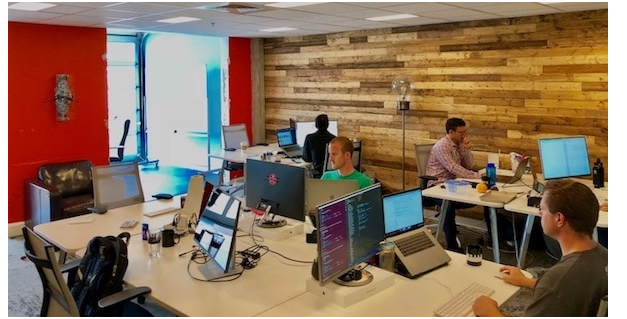You walk into your favorite co-working space, ready to tackle the day’s tasks. Little do you know, lurking in the shadows are cyber threats waiting to exploit your data.
In this article, we will uncover the hidden risks of co-working spaces and provide you with essential tips to safeguard your sensitive information.
From understanding common cyber attacks to implementing effective security measures, we’ll guide you on how to protect your data in this shared workspace environment.
Don’t let cyber threats compromise your work – read on to stay one step ahead.
Understanding the Risks: Cyber Threats in Co-Working Spaces
You should be aware of the risks posed by cyber threats in co-working spaces. When you work in a shared workspace, you are exposed to various cyber risks that can compromise your sensitive information and data privacy.
One of the main risks is the presence of unsecured Wi-Fi networks. These networks are often shared among the co-working members, making it easier for hackers to intercept your online activities and gain unauthorized access to your personal or professional accounts.

Another significant risk is the potential for physical theft of your devices, such as laptops or smartphones. In a co-working space, people come and go, and it can be challenging to keep an eye on your belongings at all times. If your device falls into the wrong hands, your sensitive data could be at risk.
Additionally, the use of shared resources, such as printers or USB ports, can also pose a threat. Malware can be easily spread through these shared resources, infecting your device and compromising your data security.
It is crucial to stay vigilant and take necessary precautions to protect yourself and your information while working in a co-working space.
Securing Data Privacy: Best Practices for Shared Workspaces
Implementing proper protocols and encryption methods is crucial to ensure the privacy of information in shared workspaces. When it comes to securing data privacy, here are some best practices you should consider:
- Secure Wi-Fi Networks: Ensure that the Wi-Fi network used in the co-working space is secure and encrypted. Use strong passwords and enable two-factor authentication for added security.
- Use VPNs: Virtual Private Networks (VPNs) create a secure connection between your device and the internet. By encrypting your data, VPNs protect your information from potential eavesdroppers.
- Implement Access Controls: Set up access controls to limit who can access sensitive information. Use strong passwords and multi-factor authentication to ensure that only authorized individuals can access confidential data.
By following these best practices, you can enhance the security of your information in shared workspaces.
Common Cyber Attacks in Co-Working Environments
Common cyber attacks that occur in co-working environments include phishing, ransomware, and man-in-the-middle attacks. As a co-worker, it is important for you to be aware of these threats and take necessary precautions to protect your data and privacy.
Phishing attacks are one of the most common cyber threats in co-working environments. Hackers send deceptive emails or messages, pretending to be a trusted source, in order to trick you into revealing sensitive information such as passwords or credit card details. Be cautious when clicking on links or downloading attachments from unfamiliar sources, and always verify the legitimacy of the sender before sharing any personal information.
Ransomware attacks are another significant threat you may face in a shared workspace. These attacks involve malware that encrypts your files and demands a ransom for their release. To protect yourself, regularly back up your data and ensure that you have reliable anti-malware software installed on your devices.
Man-in-the-middle attacks occur when an attacker intercepts communication between two parties, allowing them to eavesdrop, steal information, or manipulate data. To mitigate this risk, always use secure and encrypted networks, such as virtual private networks (VPNs), when accessing sensitive information in a co-working environment.
Implementing Effective Security Measures in Shared Workspaces
To effectively protect your information in a co-working environment, it’s crucial to establish robust security measures. Here are some steps you can take to ensure the safety of your data:
- Network Security:
- Use strong and unique passwords for all your accounts.
- Enable two-factor authentication whenever possible.
- Regularly update your software and applications to patch any security vulnerabilities.
- Physical Security:
- Keep your belongings secure by using lockers or secure storage options.
- Avoid leaving sensitive documents or devices unattended.
- Be cautious of who you allow into your workspace and ensure they are authorized individuals.
- Data Protection:
- Encrypt your files and data to prevent unauthorized access.
- Regularly backup your important files and store them securely.
- Implement reliable antivirus and firewall software to protect against malware and hackers.
By following these security measures, you can greatly reduce the risk of cyber threats and maintain the privacy of your data in a co-working environment.
Mitigating Cyber Threats: Steps to Protect Your Data in Co-Working Spaces
When using a co-working space, it’s important for you to take steps to protect your information from potential threats. With multiple individuals working in close proximity, the risk of cyber threats and data breaches is heightened.
To safeguard your data and maintain your privacy, there are several measures you can implement.
Firstly, ensure that your devices are protected with strong passwords and updated security software. This will prevent unauthorized access to your files and minimize the risk of malware infecting your devices. Additionally, make it a habit to lock your computer or log out whenever you step away from your workspace.
Furthermore, be cautious when connecting to public Wi-Fi networks in event spaces for rent. These networks are often unsecured and can be easily exploited by hackers. Consider using a virtual private network (VPN) to encrypt your internet connection and add an extra layer of security.
Another crucial step is to regularly back up your data. This ensures that even if your device is compromised, you can still retrieve your important files. Utilize cloud storage services or external hard drives for convenient and secure backups.
Lastly, be mindful of your surroundings and avoid discussing sensitive or confidential information in public areas. Take advantage of any privacy features the co-working space offers, such as private meeting rooms or soundproof booths.
Conclusion
So there you have it, coworker. You’ve learned about the dangers lurking in the shadows of shared workspaces and how to safeguard your precious data.
Remember, knowledge is power, and taking the necessary steps to protect yourself from cyber threats is essential in the modern working world.
With these best practices in place, you’ll be able to navigate the co-working landscape with confidence, like a lioness stalking her prey.
Stay vigilant and keep your data safe!





